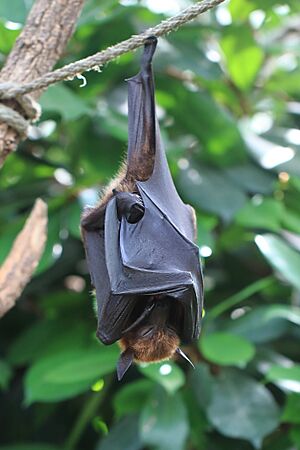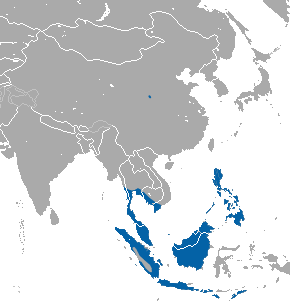Large flying fox facts for kids
Quick facts for kids Large flying fox |
|
|---|---|
 |
|
| Conservation status | |
| Scientific classification | |
| Genus: |
Pteropus
|
| Species: |
vampyrus
|
 |
|
| Large flying fox range | |
| Synonyms | |
|
|
The large flying fox (Pteropus vampyrus), also called the greater flying fox or Malayan flying fox, is a very big bat found in Southeast Asia. It belongs to a group of bats called megabats. Even though its name sounds a bit scary, it only eats fruits, nectar, and flowers. It is known for being one of the biggest bats in the world. Like most fruit bats, it cannot use echolocation (like sonar) to find its way, but it has excellent eyesight instead.
Contents
About the Large Flying Fox's Name
The large flying fox was first described by a famous scientist named Carl Linnaeus in 1758. He gave it the scientific name Vespertilio vampyrus. The word "vampyrus" comes from an old word meaning "blood-sucking ghost."
However, this bat is completely vegetarian! It mainly eats fruits. Scientists later learned that the name was chosen because people mistakenly thought it drank blood.
Scientists use mitochondrial DNA to understand how animals are related. Studies show that the closest relative to the large flying fox is the Rodrigues flying fox (Pteropus rodricensis). The large flying fox is so important that a group of similar bats is named after it, called the "vampyrus" group.
- Aldabra flying fox (Pteropus aldabrensis)
- Ryukyu flying fox (Pteropus dasymallus)
- Lyle's flying fox (Pteropus lylei)
- Indian flying fox (Pteropus medius)
- Mauritian flying fox (Pteropus niger)
- Bonin flying fox (Pteropus pselaphon)
- Little golden-mantled flying fox (Pteropus pumilus)
- Rodrigues flying fox (Pteropus rodricensis)
- Madagascan flying fox (Pteropus rufus)
- Seychelles fruit bat (Pteropus seychellensis)
What Does the Large Flying Fox Look Like?
The large flying fox is one of the biggest bat species. It can weigh between 0.65–1.1 kg (1.4–2.4 lb) (about 1.4 to 2.4 pounds). Its wings can spread up to 1.5 m (4 ft 11 in) (about 5 feet) wide! Its body is about 27–32 cm (11–13 in) long.
It has a face that looks a lot like a fox. It does not have a tail, and its ears are pointed. The fur on most of its body is long and soft, like wool. The fur on its upper back is shorter.
The color and feel of its fur can change depending on if it's a male or female, or how old it is. Young bats are usually dull gray-brown. Adult males often have lighter fur on their shoulders. Their heads can be reddish-brown, orange, or even blackish. Their undersides are usually brown or blackish.
The large flying fox has strong wings that are a bit short and rounded at the tips. This helps them fly slowly but makes them very good at turning and moving in the air. Only the parts of the wing membranes closest to the body have hair.
What Do Large Flying Foxes Eat?
This bat mainly eats flowers, nectar (the sweet liquid in flowers), and fruit. If all three are available, they usually prefer flowers and nectar. They enjoy the pollen, nectar, and flowers from coconut and durian trees. They also eat fruits like rambutan, fig, and langsat. Mangoes and bananas are also on their menu.
When eating fruit, they prefer the soft inside pulp. They will slice open the fruit's skin to get to it. When eating from durian flowers, they can lick up the nectar without harming the flower.
Behavior and Life Cycle
Flying and Feeding Habits
When large flying foxes leave their roosts, they fly in a scattered group. They might fly as far as 50 km (31 mi) (about 31 miles) in one night to find food. They don't make sounds while flying. When they reach a good feeding spot, the large group breaks into smaller family or feeding groups.
Before landing on a fruit tree, they might circle it a few times. They usually land on the tips of branches, standing upright. Then, they drop into a head-down position to start eating. When many bats are feeding together, it can get very noisy!
Resting and Social Behavior
Flowering trees are important for these bats, as they can claim them as their territory. If another bat comes too close, they might growl or spread their wings to show who's boss. They might also use their wrists or thumbs to spar, bite, or make loud noises to keep other bats away.
When a bat finds a good spot to rest, it might have to fight with other bats already there. A resting flying fox hangs upside down with its wings wrapped around itself. If it gets too warm, it will fan itself with its wings to cool down. They tend to be a bit restless until mid-morning.
Reproduction
Female large flying foxes in Peninsular Malaysia are most likely to be pregnant between November and January. However, some babies can be born in other months too. In Thailand, babies are often born in March or early April. In the Philippines, females usually give birth in April and May, and they typically have only one baby at a time.
For the first few days, mothers carry their young with them. But when they go out to find food, they leave their babies safely at the roost. The young bats stop drinking milk from their mothers when they are about two to three months old.
Where Do Large Flying Foxes Live?
The large flying fox lives in the Malay Peninsula, stretching east to the Philippines and south to Indonesian islands like Sumatra, Java, Borneo, and Timor. They often prefer areas near the coast, but they can also be found in higher places, up to 1,370 m (4,490 ft) (about 4,500 feet) above sea level.
These bats live in many different places, including primary forests, mangrove forests, coconut groves, and fruit orchards. During the day, they often rest in trees in mangrove forests or coconut groves. In Malaysia, they prefer lower areas below 365 meters (about 1,200 feet).
Flying foxes can gather in huge groups of thousands of bats. One group in a mangrove forest in Timor had about 2,000 bats. Some reports even mention colonies of 10,000 to 20,000 bats! However, mangrove roosts usually have fewer bats than other lowland resting spots, which might mean they are only used for a short time.
Large Flying Foxes and Humans
Hunting and Threats
Sadly, large flying foxes are hunted for bushmeat (meat from wild animals). In Peninsular Malaysia, many hunting permits were given out between 2002 and 2006. These permits allowed hunters to catch about 22,000 large flying foxes each year. Scientists believe that losing this many bats every year is not sustainable, meaning the population cannot recover fast enough. A study in 2009 warned that the population in Peninsular Malaysia could disappear within 6 to 81 years if hunting continues at this rate.
Nipah Virus
The large flying fox can carry the Nipah virus. Scientists believe these bats were the source of the Nipah virus outbreak in Malaysia in 1998. This was the first time the disease spread to humans and pigs. Studies have shown that the Nipah virus can stay in the bats for a long time, even if they don't show signs of it.
Conservation Status
As of 2022, the large flying fox is listed as an endangered species by the International Union for Conservation of Nature. This means its population is likely decreasing significantly. The main reasons for this decline are hunting for bushmeat and the loss of their homes due to deforestation.
The large flying fox is also listed on Appendix II of CITES. This means that international trade of these bats is controlled to help protect them. Farmers sometimes see these bats as pests because they eat fruit from their orchards. This can also lead to bats being hunted.


